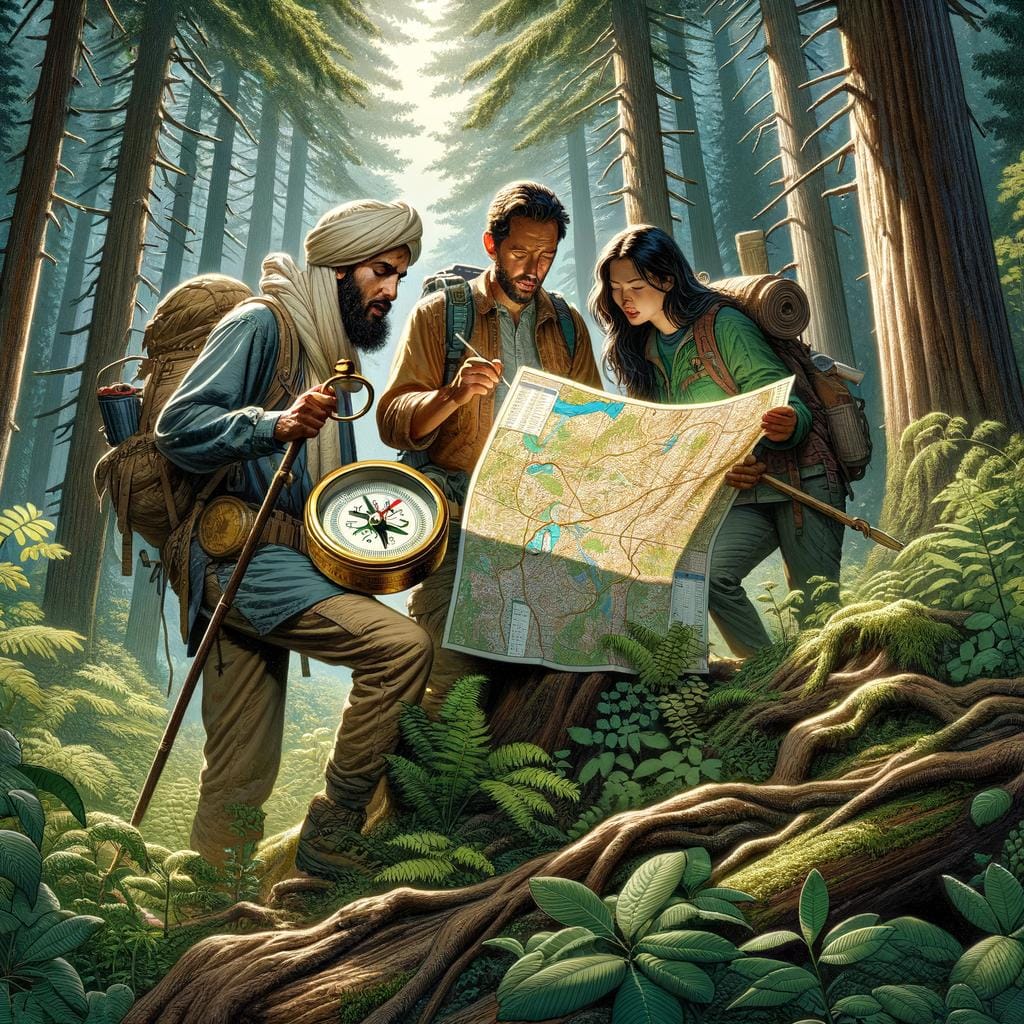Trail navigation is a crucial skill for hikers and outdoor enthusiasts, ensuring they can explore trails confidently and safely. Mastering the art of trail navigation involves understanding map reading, compass skills, and utilizing the right equipment such as GPS devices, maps, and compasses. Planning ahead is essential for a successful hiking adventure, taking into consideration factors like weather conditions and terrain.
Whether you are a beginner or an experienced hiker, having a solid foundation in trail navigation will enhance your outdoor experiences. By learning how to use landmarks and natural features to guide your way, you can navigate trails more effectively. Avoiding common mistakes in trail navigation is also key to staying on course and reaching your destination without any unnecessary setbacks.
As you delve deeper into the world of trail navigation, advanced techniques can further elevate your hiking experiences. From navigating at night with safety in mind to honing your skills for challenging terrains, there is always room for growth in mastering the art of trail navigation. Stay tuned as we explore the various aspects of trail navigation in this article to help you become a proficient navigator on your next hiking adventure.
Understanding Map Reading and Compass Skills for Trail Navigation
When it comes to trail navigation, having a solid understanding of map reading and compass skills is essential for a successful journey. While technology has made GPS devices readily available, it is still crucial to have traditional navigational skills as a backup in case of technology failure or signal loss. Here are some tips to help you improve your map reading and compass skills for trail navigation:
- Study your map before hitting the trails: Familiarize yourself with the key features on the map such as contour lines, symbols, and scale. Understanding these elements will help you interpret the terrain and plan your route effectively.
- Practice using a compass: Learning how to use a compass properly can be a lifesaver when navigating through unfamiliar terrain. Make sure you understand how to orient the map with the compass, take accurate bearings, and follow a chosen direction.
- Combine GPS with traditional skills: While GPS devices can provide accurate location information, it is important to cross-reference this data with your map and compass readings. Using both technology and traditional methods will enhance your overall trail navigation experience.
By honing your map reading and compass skills, you will have the confidence to navigate through challenging landscapes without relying solely on electronic devices. Remember that practice makes perfect, so take every opportunity to sharpen your trail navigation skills before embarking on your next outdoor adventure.
Choosing the Right Trail Navigation Equipment
When it comes to trail navigation, having the right equipment can make all the difference in ensuring a successful hiking experience. There are a variety of tools available to aid in navigation, including GPS devices, maps, and compasses. Each of these tools has its own advantages and can be used either individually or in combination for optimal results.
Here are some key points to consider when choosing the right trail navigation equipment:
- GPS Devices: GPS devices have become increasingly popular for hikers due to their ease of use and accuracy. They rely on satellite signals to determine your exact location, making them a reliable tool for navigating unfamiliar trails. However, it’s important to carry backup batteries or a portable charger in case your device runs out of power.
- Maps: Traditional paper maps are still valuable tools for trail navigation, especially in areas with poor GPS signal or as a backup in case electronic devices fail. Maps provide a broader view of the terrain and can help you plan your route more effectively.
- Compass: A compass is a basic but essential tool for any hiker. It allows you to determine your direction of travel and orient yourself on the map. Learning how to use a compass properly is crucial for accurate trail navigation, especially in challenging terrain or low visibility conditions.
By understanding the capabilities and limitations of each piece of equipment, hikers can make informed decisions about which tools to bring on their adventures. It’s also important to practice using these tools before hitting the trails to ensure proficiency in trail navigation techniques.
Remember that technology is not always foolproof, so having a solid understanding of map reading and compass skills can be invaluable in situations where GPS signal is weak or unavailable. By being prepared with the right equipment and knowledge, hikers can navigate confidently through various terrains and enjoy their outdoor experiences even more.
Top Tips for Planning Your Trail Navigation Adventure
Planning is essential when embarking on a trail navigation adventure to ensure a safe and enjoyable experience. One of the top tips for planning your trail navigation adventure is to thoroughly research the trail you will be hiking. This includes understanding the terrain, elevation changes, potential hazards, and any specific points of interest along the way. By having a good grasp of what to expect, you can better prepare yourself both mentally and physically for the journey ahead.
Another important tip is to create a detailed itinerary before setting out on your hike. This should include information such as your starting point, planned route, estimated time of arrival at key waypoints, and your intended end point. By mapping out your itinerary in advance, you can track your progress more effectively and ensure that you stay on schedule throughout the hike. It also serves as a useful reference point in case of emergencies or unexpected delays.
Additionally, consider the weather conditions and seasonal factors when planning your trail navigation adventure. Weather can play a significant role in hiking safety and comfort, so it’s important to check weather forecasts leading up to your hike and pack accordingly.
Be prepared for any sudden changes in weather by bringing appropriate clothing layers, food, water, and other essential supplies. By taking these precautions into consideration during the planning phase, you can set yourself up for success on your trail navigation adventure.
Common Trail Navigation Mistakes to Avoid
Navigating along trails can be an exhilarating experience, but it is important to remember that getting lost in the wilderness can quickly turn an adventure into a dangerous situation. To ensure a safe and successful hike, it is crucial to avoid common trail navigation mistakes that could easily be prevented with proper planning and awareness.
Overreliance on Technology
One of the most common mistakes hikers make is relying too heavily on technology such as GPS devices or smartphone apps for trail navigation. While these tools can be helpful, they are not foolproof and can fail due to a dead battery, loss of signal, or technical malfunction. It is essential to always carry a physical map and compass as backup, as well as have basic map reading and compass skills in case technology fails.
Failure to Plan Ahead
Another mistake that hikers often make is not adequately planning their route before setting out on the trail. Failing to familiarize oneself with the trail beforehand can lead to confusion, wrong turns, and wasted time trying to backtrack. Before embarking on a hiking trip, take the time to research the trail, study maps, understand the terrain and elevation changes, and set realistic time estimates for completing the hike.
Ignoring Landmarks and Natural Cues
Disregarding landmarks and natural features along the trail is another common mistake that can lead hikers astray. Paying attention to distinctive landmarks such as rock formations, rivers, tree groves, or mountain peaks can help you stay on course and pinpoint your location if needed. By using these cues in conjunction with your map and compass skills, you can enhance your trail navigation abilities and reduce the risk of getting lost. Remember that nature provides valuable clues for successful orienteering.
How to Use Landmarks and Natural Features for Trail Navigation
Landmarks and natural features can be invaluable tools for trail navigation, especially in situations where maps or GPS devices may not be accessible or reliable. By understanding how to recognize and utilize these features, hikers can enhance their ability to navigate through various terrains with ease.
One commonly used natural feature for trail navigation is water sources such as rivers, streams, or lakes. These bodies of water can serve as prominent landmarks that are easily identifiable on maps and in the surrounding environment. Additionally, they often flow in a particular direction, which can help hikers determine their own orientation and route. When planning a hiking trip, it’s beneficial to include water sources as reference points along the way.
Another important natural feature for trail navigation is vegetation, including trees, shrubs, and other plant life. Different types of vegetation can indicate specific terrain characteristics such as dense forests, open fields, or elevation changes. By paying attention to the vegetation around them, hikers can make informed decisions about their route and avoid potential obstacles. For example, dense tree cover might suggest a denser forest area that could be challenging to navigate through.
In addition to using natural features like water sources and vegetation for trail navigation, hikers should also take note of prominent landmarks such as mountains, rock formations, or distinctive tree formations. These features can act as visual cues that help maintain a sense of direction and progress along the trail. By combining an awareness of both natural and man-made landmarks, hikers can increase their confidence in navigating unfamiliar terrain successfully.
| Natural Features | Trail Navigation Tips |
|---|---|
| Water Sources (rivers, lakes) | Use directions of flow for orientation |
| Vegetation (trees, shrubs) | Identify terrain characteristics |
| Prominent Landmarks (mountains, rock formations) | Act as visual cues for direction |
Navigating at Night
Importance of Nighttime Trail Navigation Safety
Navigating trails at night presents unique challenges such as reduced visibility, potential disorientation, and an increased risk of injury. Without the proper precautions, hikers can easily become lost or disoriented in the darkness. It is crucial to prioritize safety when embarking on a nighttime hike by taking necessary steps to minimize risks and ensure a safe journey.
Safety Tips for Navigating Trails at Night
One essential safety tip for nighttime trail navigation is to always inform someone of your plans before heading out. Let a friend or family member know your planned route, expected return time, and any relevant details. In case of emergency, this information can be crucial for search and rescue efforts.
Additionally, carrying a reliable light source such as a headlamp or flashlight is essential for illuminating the trail ahead and ensuring visibility in the dark. It is also advisable to bring extra batteries or backup lighting equipment to avoid being left in darkness unexpectedly.
Advanced Trail Navigation Techniques for Experienced Hikers
Experienced hikers who have mastered the basics of trail navigation may be eager to learn more advanced techniques to enhance their outdoor adventures. One key skill that sets experienced hikers apart is their ability to navigate off-trail or in challenging terrain. This requires a deeper understanding of map reading, compass skills, and utilizing natural features to plot a course. By honing these skills, experienced hikers can explore remote areas with confidence and precision.
One advanced technique for trail navigation is using triangulation to pinpoint your location on a map. This involves identifying at least two prominent landmarks or features in the distance, measuring their bearing from your current position, and plotting them on the map. Where the lines intersect is likely where you are located. This method is particularly useful in open terrain where landmarks are visible and can help you navigate accurately without relying solely on trails or GPS devices.
Another advanced technique for experienced hikers is learning how to interpret contour lines on a topographic map. Contour lines represent changes in elevation, and by understanding how to read them, hikers can anticipate steep slopes, valleys, ridges, and other terrain features before reaching them.
This knowledge not only aids in route planning but also enhances safety by avoiding unexpected obstacles or difficult terrain. Additionally, experienced hikers should practice dead reckoning – estimating your current position based on distance traveled, direction taken, and known landmarks – to maintain situational awareness even in challenging conditions.
| Advanced Technique | Description |
|---|---|
| Triangulation | Using prominent landmarks to pinpoint location on a map. |
| Contour Line Interpretation | Understanding elevation changes for route planning. |
| Dead Reckoning | Estimating current position based on distance traveled. |
Conclusion
In conclusion, mastering the art of trail navigation is crucial for a seamless and enjoyable hiking experience. Being able to effectively read maps, use a compass, and choose the right equipment such as GPS devices can greatly enhance your adventures on the trails. Planning ahead, avoiding common mistakes, and utilizing landmarks and natural features can help you stay on course and make the most out of your hike.
For those looking to take their trail navigation skills to the next level, there are advanced techniques that experienced hikers can explore. These may include using triangulation, dead reckoning, or celestial navigation methods to navigate more challenging terrains. By continuously honing your trail navigation skills, you can increase your confidence in exploring new trails and remote areas.
Remember, trail navigation is not just about reaching your destination but also about enjoying the journey itself. With practice, patience, and a good understanding of navigation principles, you can navigate with ease through various landscapes and terrains. So next time you hit the trails, put your trail navigation skills to the test and immerse yourself in the beauty of nature while exploring new paths with confidence and precision.
Frequently Asked Questions
How Do You Navigate a Trail?
Navigating a trail requires some preparation and attention to detail. It’s crucial to have a map or GPS device to stay on course. Pay attention to trail markers, landmarks, and any signage along the way.
Can You Use Google Maps for Trails?
Google Maps can be used for trails, but it may not always provide detailed information on hiking paths or specific trail conditions. While it can be a helpful tool for general navigation, outdoor-specific apps like AllTrails may offer more detailed trail information.
Is AllTrails Navigation Free?
AllTrails offers both free and paid versions of their navigation services. The free version allows users to access a limited number of trails and basic features. For more advanced features like offline maps and additional map layers, users may need to upgrade to a paid subscription.

An avid outdoor enthusiast, writer, and environmental advocate who has spent over two decades exploring the world’s most breathtaking landscapes. With a background in environmental science and a passion for adventure, Frances combines her love for nature with her talent for storytelling to inspire others to embark on their own outdoor journeys.





